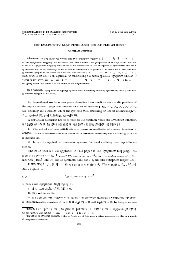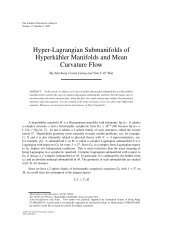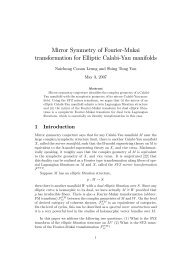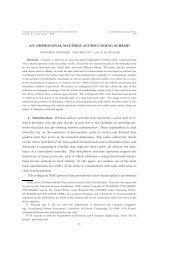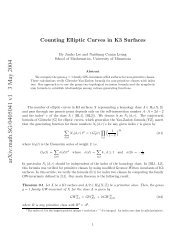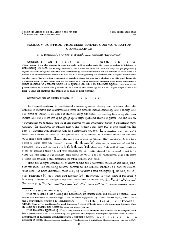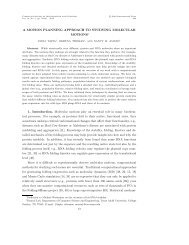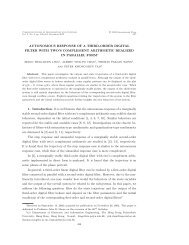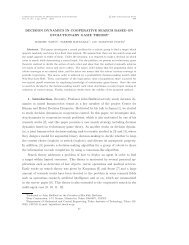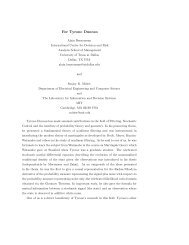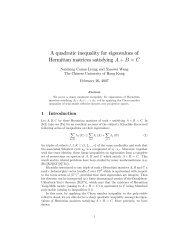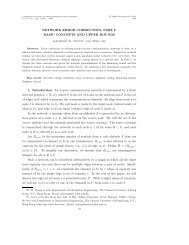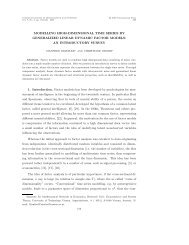AN OPTIMAL DISTRIBUTED ROUTING ALGORITHM USING DUAL ...
AN OPTIMAL DISTRIBUTED ROUTING ALGORITHM USING DUAL ...
AN OPTIMAL DISTRIBUTED ROUTING ALGORITHM USING DUAL ...
Create successful ePaper yourself
Turn your PDF publications into a flip-book with our unique Google optimized e-Paper software.
300 PUNYASLOK PURKAYASTHA <strong>AN</strong>D JOHN S. BARAS<br />
(37) and (38), which in our example are the equations<br />
F ij (z n ) = 0, if z n ij ≤ 0,<br />
F ij (z n )<br />
C ij − F ij (z n ) = zn ij , if zn ij > 0.<br />
The latter equation gives F ij (z n ) = zn ij Cij<br />
1+z<br />
, a simple expression, showing that the flow<br />
ij<br />
n<br />
is proportional to the capacity.<br />
We use a constant step-size algorithm (γ n = γ, for all n) with the step-size<br />
γ = 0.01. (This choice of small γ slows down the convergence of the algorithm. As<br />
pointed out in Section 4.2, other choices of step-size sequences can potentially improve<br />
the speed of convergence.) The ǫ chosen for the ǫ-relaxation method is 0.01.<br />
The subgradient algorithm converges and the optimal flows (upon convergence)<br />
are tabulated in Table 4. As in Section 3 we note that the optimal routing solution<br />
allocates a higher fraction of total incoming flows at every node to outgoing links that<br />
lie on paths consisting of higher capacity links.<br />
The optimal routing solution splits the total incoming flow at each node among<br />
the outgoing links. The solution also describes how the total flow on each link is split<br />
among the commodity flows. We also note that our routing solution is a multipath<br />
routing solution. It is well-known [3] that multipath routing solutions improve the<br />
overall network performance by avoiding routing oscillations (shortest-path routing<br />
solutions, for instance, are known to lead to routing oscillations), and by providing<br />
better throughput for incoming connections, while at the same time reducing the<br />
average network delay.<br />
Our routing solution is not an end-to-end routing solution, as for example [18].<br />
The control is not effected from the end hosts, but every node i in the network controls<br />
both the total as well as the commodity flows on its outgoing links (i, j), using the<br />
distributed algorithm.<br />
Appendix A. Lemma 3. Under our Assumptions (A1) and (A2), there exists<br />
a unique solution to the following minimization problem (for any given w ij ),<br />
Minimize G ij (F ij ) − w ij F ij = ∫ F ij<br />
0<br />
u[D ij (u)] β du − w ij F ij ,<br />
subject to 0 ≤ F ij < C ij .<br />
Proof. For any given w ij , H ij (F ij ) = G ij (F ij ) − w ij F ij increases to +∞ as<br />
F ij ↑ C ij (Assumption (A2)). Consequently, there exists an M ∈ [0, C ij ), such that<br />
H ij (F ij ) > H ij (0) whenever F ij > M. The function H ij (F ij ) restricted to the domain<br />
[0, M] attains the (global) minimum at the same point as the function considered<br />
on the set [0, C ij ). The set [0, M] is compact; applying Weierstrass theorem to the<br />
continuous function H ij (F ij ) on this set gives us the required existence of a minimum.<br />
Uniqueness follows from the fact that H ij (F ij ) is strictly convex on [0, C ij ).




